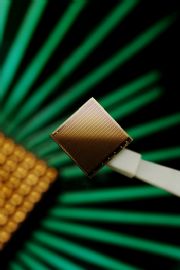 Intel plans to invest $7 billion to revamp factories in three states to manufacture chips based on its new technology. The move, which attracted the attention of , may be the first real good news has seen in months.
Intel plans to invest $7 billion to revamp factories in three states to manufacture chips based on its new technology. The move, which attracted the attention of , may be the first real good news has seen in months.
The announcement comes as Congress works out a details of an $800 billion-plus . Obama warned during a press conference last night that the U.S. faces catastrophic consequences to the economy if a stimulus isn't acted
will be drawing into its own cash reserves to upgrade facilities in Arizona, New Mexico and Oregon, said Intel president and at an Economic Club forum here today. "Taking that leap can be downright scary but it is the only proven path to pull out of bad times," he said. "If we want to see a return to American prosperity, we have no choice than to invest in creating the future, not merely preserving the past."
Otellini called on other companies to make such private investments. "I am asking other companies to join us," he said.
Otellini said Obama called him last night to congratulate him on company's decision. The president "reminded me that he sees the Intel logo every morning when he opens up his laptop - I was please to hear that," he noted
Otellini also noted that he told Obama "that I thought there were many elements of [the proposed stimulus package] that I could get behind," particularly health care IT, alternative energy, broadband investments, and money for the , which funds basic research at U.S. universities. "Those kinds of things are spectacular," he said.
The new Intel manufacturing facilities, which will build , will employ some 7,000 U.S. workers, Otellini said.
This announcement comes less than a month after . Otellini said today that most the cuts have come overseas, where Intel has closed obsolete smaller plants. He added that once the factories are completed, Intel's U.S. workforce be larger than today, though he didn't provide specifics. Intel today employs about 45,000 people in the U.S., and 83,000 worldwide, he noted. The worldwide total is about 25,000 less than the company employed at its peak in 2005, Otellini said.
Construction of the manufacturing facilities will take 18 to 24 months by thousands of contractors and construction workers, said Otellini.
Intel could have built its 32 nanometer manufacturing facilities overseas, and foreign countries, unlike the U.S., were ready to offer hundreds of millions of dollars, if not more, in incentives, said Otellini.
Many U.S. tech firms have shifted work overseas because of lower labor costs, but Otellini said that the chip manufacturing factories "are not driven by labor costs." He said that taking advantage of the company's existing U.S. workforce allows Intel to bring these manufacturing facilities "up much faster," which "outweighs any offsetting costs."
Today, chip makers are producing 45nm chips. Moore's Law states that the number of transistors on a chip doubles about two years. A 45nm quad core chips has about 800 million transistors. Intel's first 32nm chip, code named Westmere, is expected later this year.